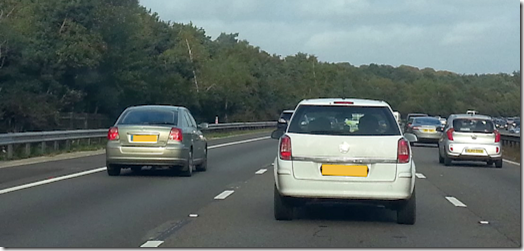 This story has appeared in a few newspapers recently. It concerns the stopping distances in the Highway Code (HC), and “research” by Brake – which is usually involved when anything like this kicks off. The charge being levelled this time is that the HC is wrong, and stopping distances are actually much longer.
This story has appeared in a few newspapers recently. It concerns the stopping distances in the Highway Code (HC), and “research” by Brake – which is usually involved when anything like this kicks off. The charge being levelled this time is that the HC is wrong, and stopping distances are actually much longer.
The first thing to point out, even though the forums are already running with it – is that only the typical driver’s reaction time is being questioned. It has nothing to do with the actual braking distance (remember that overall stopping distance is equal to the thinking distance + braking distance). The second thing to recognise is that it isn’t even a new issue. It had been ably discussed at least as long ago as June 2016 on Chalkdust Magazine. If I was being cynical I would suggest that Brake had been at a bit of a loose end since its last crusade, seen this article, and picked up the reins.
The HC’s standard figures for stopping distances date back to the 60s, and this has led many to argue that they must be out of date for that reason alone. Consequently, most arguments start with the premise that stopping distances are wrong because cars have improved, and then proceed to cherry-pick disparate data which appear to support that premise. Most arguments focus on the braking distance.
I’m not going to repeat Chalkdust’s excellent calculations here, but it is important to understand from the outset that the braking distance in real situations has nothing to do with the weight of the vehicle. Braking distance is all to do with friction, and since any vehicle on the road has brakes which can freeze the wheels instantaneously if they’re applied hard enough, and an amount of rubber in contact with the road surface which is proportional to the size and weight of the vehicle, it is the overall friction between the tyres and the road which matters most.
As an aside, tyres are better today than they were in the 60s, road surfaces are better, and brake systems are better. So, if anything, a car in the 21st Century would probably stop more efficiently than one in the 60s did. But as I say, the issue isn’t about braking distance.
Chalkdust pointed out in 2016 that the HC stopping distances allow for a thinking time of 0.68 seconds, and they suggest that this appears to have been chosen because it meant that the “thinking distance” in feet is the same as the speed in mph – which is one of the methods learners use to memorise the stopping distances table in the HC. By comparison, the United States uses 1.5 seconds thinking time, and Canada assumes 2.5 seconds. Chalkdust suggests a new “thinking distance” in metres which is numerically equal to mph, and which equates to 2.24 seconds thinking time.
Brake has decided to argue something completely different, coincidentally adopting the American thinking time of 1.5 seconds (but allegedly following “research” into “average thinking times”). Consequently, its proposed stopping distances are somewhat shorter than Chalkdust’s – and horrendously un-rememberable!
Even without the decimal fractions, there is no pattern to aid remembering them. At least with Chalkdust’s figures, the “thinking distance” is memorable, thus more or less eliminating one of the variables involved. Let’s not forget that knowing or remembering the distances is one of the primary concerns here – it isn’t an exercise in having precise distances nailed down.
In my opinion – and I’ve said this before – knowing the actual stopping distance at any given speed is as useful as a chocolate fireguard. However, knowing that the current 70mph stopping distance is about as long as a football pitch is much more useful (compared with knowing it is 315 feet or 96m). Let’s face it, if you’re in a situation where this is suddenly important, and you’re trying to push the pedals through the floor to avoid something in front of you, you’re not going to be worrying about how far 96m is from where you are now.
The “two-second rule” (which would probably become the four or five second rule based on this), or some variation of it, is infinitely more useful.
Modern cars are lighter than they were in the 60s
No, they’re not. A Ford Anglia – the car allegedly used to set the current numbers – weighed about 740kg. A Ford Focus weighs around 1,400kg. Even a Citroen C1 weighs over 800kg. A BMW Mini weighs about 1,200kg, compared with about 650kg for an original Mini back in the 60s.
Tyres were different back then
Yes, and they are unlikely to have been as good as those we have today. Modern cars have better tyres and better brakes, and more of the tyre is in contact with the road. Modern roads have better grip. If anything, modern cars ought to be able to stop more quickly that their 60s counterparts could until you factor in their weight. The original distances are probably still a fairly good indicator.